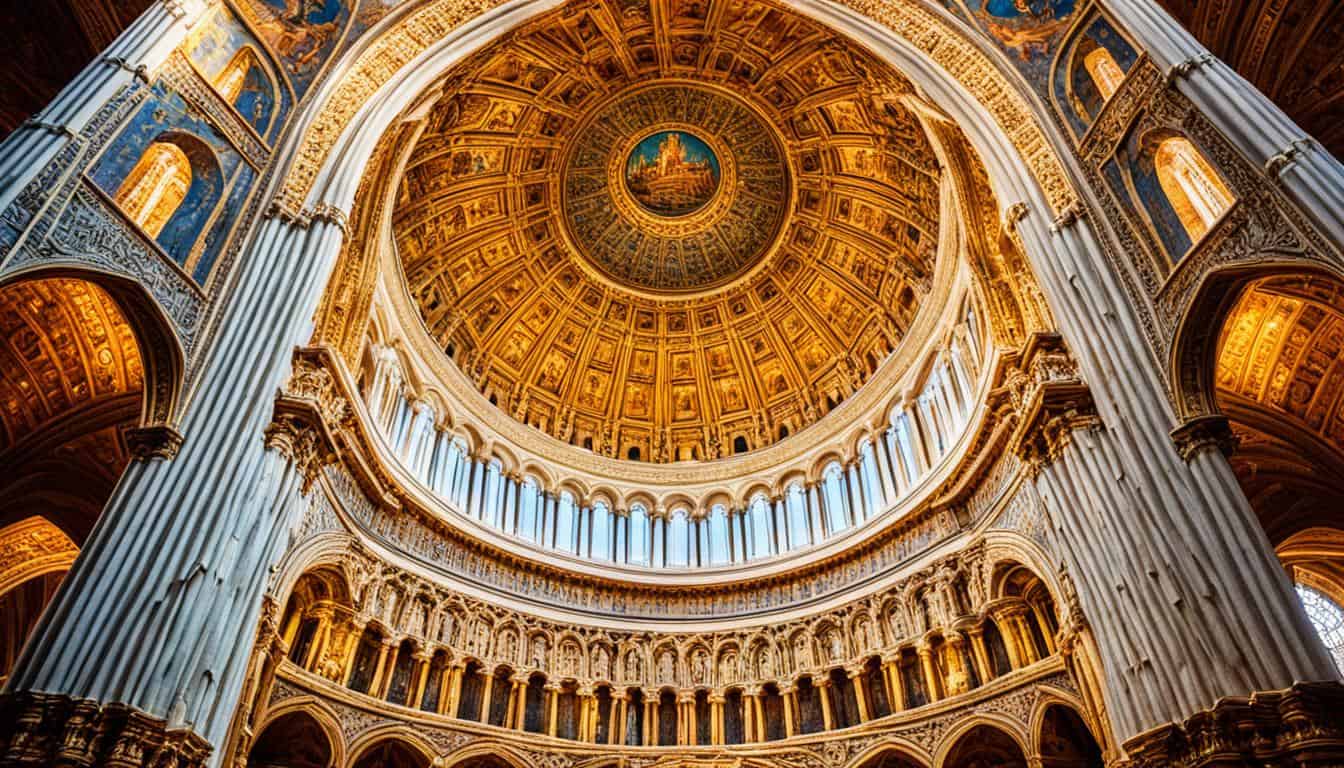Table of Contents
Have you ever wondered why Zion and the Temple hold such a significant place in biblical worship?
Why are these sacred spaces so crucial to believers, symbolizing God’s presence and offering a gateway to communication with Him?
And how do Zion and the Temple connect to Jesus and His message of salvation?
In this article, we will explore the profound roles of Zion and the Temple in biblical worship, uncovering their spiritual significance and unraveling the deep-rooted connections to Christ.
Prepare to embark on a journey that will challenge your perceptions and greatly enrich your understanding of central places of worship in the Bible.
Zion as God’s Holy Mountain: Representing God’s Presence in the Bible
Zion, known as God’s Holy Mountain, holds a significant place in the Bible, symbolizing His presence among His people. Throughout Scripture, references to Zion provide glimpses of Jesus and His role as the Messiah within this sacred space.
In the Old Testament, Zion is described as the dwelling place of God and the center of worship. It is a place where God’s glory resides and where His people gather to seek His presence. The Psalms often speak of Zion with reverence and longing, highlighting its significance in biblical worship.
One notable reference to Zion can be found in Psalm 48:1-2: “Great is the LORD, and greatly to be praised in the city of our God, in the mountain of his holiness.
Beautiful for situation, the joy of the whole earth, is mount Zion, on the sides of the north, the city of the great King.” This passage emphasizes the magnificence of Zion as the dwelling place of the Lord and the source of joy for all people.
“Great is the LORD, and greatly to be praised in the city of our God, in the mountain of his holiness. Beautiful for situation, the joy of the whole earth, is mount Zion, on the sides of the north, the city of the great King.” – Psalm 48:1-2
These references to Zion as God’s Holy Mountain serve as hints and foreshadowing of Jesus’ role as the Messiah. Just as Zion was the physical representation of God’s presence in the Old Testament, Jesus embodies God’s presence in the New Testament.
Jesus often referred to Himself as the fulfillment of the Old Testament prophecies, including those related to Zion. In John 2:19, Jesus says, “Destroy this temple, and I will raise it up in three days.”
This statement foreshadows His crucifixion, death, and resurrection, symbolically linking Himself to the temple and, by extension, to Zion.
“Destroy this temple, and I will raise it up in three days.” – John 2:19
Furthermore, Hebrews 12:22-24 connects believers to Zion, describing it as the heavenly Jerusalem and the assembly of the firstborn. This passage indicates that through faith in Jesus, believers become partakers of the heavenly Zion, where they can approach God with confidence.
By recognizing Zion as God’s Holy Mountain and understanding its significance in the Bible, we gain deeper insight into God’s presence among His people and the role of Jesus as the Messiah. It reminds us of the eternal worship and communion we have with God through faith in Christ.
| Zion as God’s Holy Mountain | God’s presence in the Bible | Hints of Jesus in sacred space |
|---|---|---|
| Zion symbolizes God’s dwelling place | References to Zion emphasize God’s presence | Zion foreshadows Jesus as the Messiah |
| Zion is the center of worship | Zion represents joy and beauty in Scripture | Jesus fulfills the prophecies related to Zion |
| Believers are connected to the heavenly Zion | Zion signifies the assembly of the firstborn | Through faith, we have access to God in Zion |
The Temple as a House of Prayer: Communication with God
The Temple, in all its splendor, held a profound purpose as a house of prayer. It was a sacred space where believers could connect with God through the act of prayer. Prayer served as a means of communication, allowing individuals to express their hopes, fears, and desires to the Almighty.
It was a way to seek guidance, find solace, and offer gratitude. The Temple provided a physical location that facilitated this intimate connection with God, offering a space where individuals could quiet their minds, open their hearts, and find solace in the presence of the divine.
Every aspect of the Temple was designed to enhance this sacred communication. The intricate architecture, the sacred rituals, and the offerings presented an environment conducive to prayer and worship.
The grandeur and beauty of the Temple were intended to inspire awe and reverence, setting the stage for a deep and meaningful encounter with the divine.
Prayer in the Temple was not merely a ritualistic exercise; it held a deeper significance. It was a reminder of the people’s dependence on God and their desire to be in communion with Him.
The act of prayer served as a channel through which individuals could pour out their hearts and seek God’s presence, guidance, and intervention in their lives.
“My house shall be called a house of prayer for all nations.” – Isaiah 56:7
Jesus himself recognized the importance of prayer in the Temple. He overturned tables and drove out those who had turned the sacred space into a marketplace, emphasizing the true purpose of the Temple as a house of prayer. Through this act, Jesus reaffirmed the significance of prayer in connecting with God.
As believers today, we can learn from the role of prayer in the Temple. While we may not have a physical Temple in the same sense as in biblical times, we can still create sacred spaces within our hearts and homes where we can commune with God.
Just as the Temple provided a dedicated space for prayer, we can designate a quiet corner or a specific time of day for seeking God in prayer.
Whether it is through spoken words, silent contemplation, or even written expressions, prayer allows us to connect with God, share our hearts, and receive His guidance and comfort.
It is a powerful means of communication with the divine, enabling us to cultivate a deep and personal relationship with our Creator.
In summary, the Temple served as a house of prayer, providing believers with a dedicated space to communicate with God. Prayer was an integral part of worship, offering a channel through which individuals could express their deepest longings and seek God’s presence.
While the physical Temple may no longer exist, the role of prayer in connecting with God remains as relevant today as it was in biblical times.
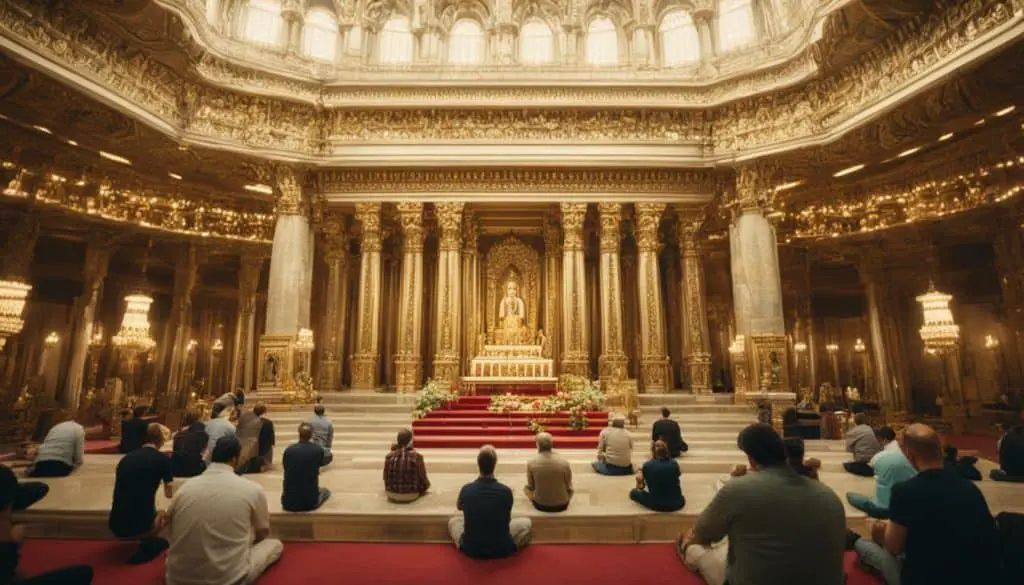
Jesus Cleansing the Temple: Reverence for Sacred Spaces and His Authority
When Jesus entered the Temple in Jerusalem, he was confronted by a scene that deeply troubled him. The sacred space intended for worship and reverence had been transformed into a market, filled with merchants and moneychangers.
In a display of righteous indignation, Jesus cleansed the Temple, driving out those who had turned it into a place of commerce.
This episode of Jesus cleansing the Temple is significant for several reasons. Firstly, it demonstrates Jesus’ reverence for sacred spaces.
The Temple held profound religious and spiritual significance for the Jewish people as the dwelling place of God. Jesus’ actions affirmed the sanctity of the Temple and the need to preserve its reverence.
“My house shall be called a house of prayer,” Jesus declared, quoting from Isaiah. “But you have made it a den of thieves!” (Matthew 21:12-13)
In driving out the merchants and moneychangers, Jesus asserted his authority over the Temple.
He exercised his divine power to restore the sacredness of the space and to uphold its intended purpose as a house of prayer and worship. This display of authority revealed Jesus’ role as the Messiah and the Son of God.
The cleansing of the Temple serves as a powerful lesson for believers today. It reminds us of the importance of approaching places of worship with reverence and respect.
Just as Jesus cleansed the Temple, we are called to purify our hearts and minds when we enter sacred spaces, whether it be a church, synagogue, or mosque.
Jesus’ cleansing of the Temple also challenges us to examine our own lives and the areas where we may have allowed the profane to invade the sacred. It prompts us to reflect on how we can ensure that our worship and devotion remain pure and focused on God.
In conclusion, Jesus’ cleansing of the Temple reveals his reverence for sacred spaces and his authority over them. It serves as a reminder for believers to approach places of worship with reverence and to uphold their sanctity.
By emulating Jesus’ example, we can create environments that foster genuine worship, free from the distractions of the world.
The Temple Veil Torn: Jesus’ Role in Granting Direct Access to God
When Jesus was crucified, an extraordinary event occurred in the temple. The heavy veil that separated the Holy of Holies, the most sacred part of the temple, from the rest of the temple was torn in two.
This tearing of the temple veil holds profound significance, symbolizing Jesus’ role in granting direct access to God.
Prior to this event, only the high priest was allowed to enter the Holy of Holies once a year on the Day of Atonement to make atonement for the sins of the people. The veil served as a barrier, representing the separation between humanity and the holiness of God.
However, when Jesus died on the cross, the veil was torn from top to bottom, signifying the removal of this barrier and the opening of a direct pathway to God.
This act was highly symbolic and significant in multiple ways. Firstly, it demonstrated Jesus’ authority and power over the temple. As the Son of God and the ultimate High Priest, Jesus had the authority to remove the separation and grant unhindered access to God.
Secondly, the tearing of the veil signified the completion of Jesus’ mission to reconcile humanity with God. Through His sacrificial death, Jesus atoned for our sins and bridged the gap between us and God.
The tearing of the veil represented the removal of sin’s barrier, allowing us to approach God directly.
This act also marked the end of the Old Covenant and the inauguration of the New Covenant. In the Old Testament, access to God was limited and mediated through sacrificial rituals. However, through Jesus’ sacrifice, we now have direct access to God, with no need for an intermediator or elaborate rituals.
“Therefore, brethren, having boldness to enter the Holiest by the blood of Jesus, by a new and living way which He consecrated for us, through the veil, that is, His flesh…” (Hebrews 10:19-20)
Furthermore, the tearing of the veil demonstrated God’s desire for intimate fellowship with His people. Through Jesus, we have direct communion with God, being able to approach Him boldly and without fear.
The tearing of the veil emphasizes the love and accessibility of God, inviting us to come into His presence and experience His grace and mercy.
In conclusion, the tearing of the temple veil is a powerful symbol of Jesus’ role in granting direct access to God. It represents His authority, His completed mission of reconciliation, and the inauguration of the New Covenant.
Through Jesus, we can approach God without barriers, experiencing a deep, personal relationship with Him. The tearing of the veil invites us to embrace this extraordinary privilege and boldly enter into God’s presence.
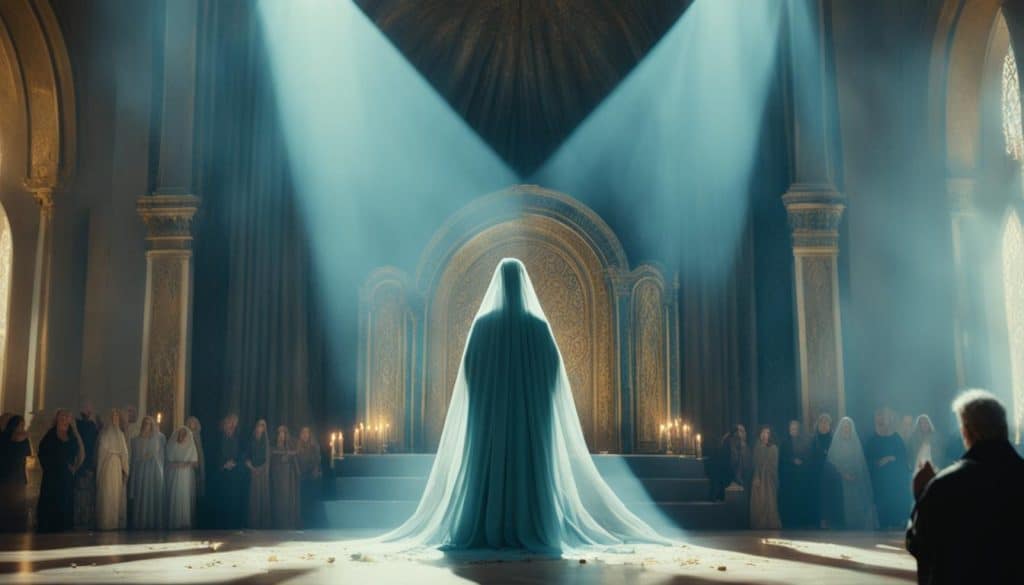
The Significance of the Temple Veil Torn
- The tearing of the temple veil symbolizes Jesus’ authority and power over the temple.
- It represents the completion of Jesus’ mission to reconcile humanity with God.
- The tearing of the veil marks the end of the Old Covenant and the inauguration of the New Covenant.
- It signifies our direct access to God without the need for intermediaries or elaborate rituals.
- The tearing of the veil demonstrates God’s desire for intimate fellowship with His people.
The Veil Torn: A Testament to Jesus’ Mission
“Then, behold, the veil of the temple was torn in two from top to bottom…” (Matthew 27:51)
The tearing of the temple veil was a significant moment in history, testifying to Jesus’ mission of granting direct access to God.
Through His sacrificial death and resurrection, Jesus opened the way for all believers to come boldly into God’s presence. The torn veil serves as a reminder of the grace, love, and accessibility of our Heavenly Father.
Jesus as the Cornerstone: Illustrating Jesus as the Cornerstone of Spiritual Zion
Throughout Scripture, Jesus is described as the cornerstone, representing His foundational role in spiritual Zion. This metaphor exemplifies the significance of Jesus’ role in our faith and the eternal truth He embodies.
Just as a cornerstone provides stability and support for the entire structure, Jesus acts as the sure foundation upon which our spiritual lives are built. He is the cornerstone of our faith, the anchor that keeps us grounded in truth and salvation.
In Matthew 21:42, Jesus refers to Himself as the “stone which the builders rejected,” acknowledging that while many may overlook or reject Him, He is the essential piece that holds everything together. By embracing Jesus as the cornerstone, we recognize His authority, wisdom, and divine purpose in our lives.
“The stone which the builders rejected, the same is become the head of the corner: this is the Lord’s doing, and it is marvelous in our eyes.” – Matthew 21:42
As the cornerstone, Jesus assumes a central role in the spiritual Zion, the community of believers. He unifies us, bringing together people from all walks of life, cultures, and backgrounds under His divine authority.
Just as the cornerstone connects and aligns the various parts of a building, Jesus connects and aligns us as His followers, creating a spiritual family that transcends human divisions.
Furthermore, the image of Jesus as the cornerstone reminds us that He is the source of our strength, stability, and purpose. Without Him, our faith would crumble, and our lives would lack true meaning.
Jesus’ teachings, sacrificial love, and redemptive work provide the solid foundation upon which we can grow, flourish, and fulfill our divine calling.
The significance of Jesus as the cornerstone extends beyond our individual lives. It extends to the entire body of Christ, the Church. With Jesus as our cornerstone, the Church becomes a living testament to His grace and power, a place where believers come together to worship, serve, and impact the world.
“And are built upon the foundation of the apostles and prophets, Jesus Christ himself being the chief corner stone… In whom all the building fitly framed together groweth unto an holy temple in the Lord.” – Ephesians 2:20-21
Just as the cornerstone determines the position and alignment of each stone in a building, Jesus determines the purpose and direction of our lives as believers. We look to Him for guidance, inspiration, and strength as we navigate the complexities of life and fulfill our God-given mission.
Seeing Jesus as the cornerstone of our faith and spiritual Zion transforms our worldview, establishing a secure foundation upon which we can build our lives. By embracing Jesus as the cornerstone, we find true peace, purpose, and eternal significance.

| Key Takeaways |
|---|
| Jesus is often described as the cornerstone, representing His foundational role in spiritual Zion. |
| He provides stability, support, and unity within the community of believers. |
| Jesus is the source of strength, stability, and purpose in our lives, both individually and collectively as the Church. |
| He determines the position, alignment, and direction of our lives as we navigate our faith journey. |
| Embracing Jesus as the cornerstone transforms our worldview, giving us a solid foundation on which to build our lives. |
The Temple and Sacrifices: Foreshadowing Jesus’ Ultimate Sacrifice
The temple sacrifices in the Old Testament serve as a powerful foreshadowing of Jesus’ ultimate sacrifice. These sacrificial practices, meticulously outlined in the book of Leviticus, hold profound significance in understanding the redemptive work of Jesus and His role as the ultimate sacrifice for our sins.
“For it is not possible that the blood of bulls and of goats should take away sins.” – Hebrews 10:4
Throughout the Old Testament, animal sacrifices were offered at the temple as a means of atonement for the sins of the people. The high priest would enter the Holy of Holies once a year, sprinkling the blood of sacrifices on the mercy seat to cleanse the people from their transgressions.
This sacrificial system foreshadowed the coming of Jesus, who would offer Himself as the perfect and final sacrifice for the sins of humanity.
Just as the blood of animals could not truly take away sins, Jesus’ sacrifice on the cross provided the ultimate atonement and opened the way for reconciliation between God and mankind.
By examining the details of the temple sacrifices, we gain a deeper understanding of Jesus’ sacrificial act.
The animals symbolize the weight of sin and the need for a perfect sacrifice to redeem humanity. Jesus, the spotless Lamb of God, fulfilled this need by willingly offering Himself as the ultimate sacrifice.
Jesus’ Death and Resurrection: The Fulfillment of Temple Sacrifices
The foreshadowing of Jesus’ sacrifice in the temple becomes even more evident when we consider the events surrounding His death and resurrection. Just as the lamb was killed and its blood shed for the forgiveness of sins, Jesus, the Lamb of God, laid down His life and shed His blood for the salvation of all.
“And walk in love, as Christ also hath loved us, and hath given himself for us an offering and a sacrifice to God for a sweetsmelling savour.” – Ephesians 5:2
The tearing of the temple veil at the moment of Jesus’ death symbolizes the removal of barriers that separated humanity from God. Through His sacrifice, Jesus granted us direct access to the Father, bridging the gap that sin had created.
Furthermore, just as the Israelites had to apply the blood of the sacrifice to the doorposts of their homes for protection during the Passover, we must personally apply the blood of Jesus through faith for our salvation.
His sacrifice is not only a historical event but a personal invitation for each of us to experience forgiveness and eternal life.
The temple sacrifices in the Old Testament were a glimpse into the future, pointing towards Jesus’ sacrificial act of love on the cross.
As we contemplate the significance of these sacrifices, we are reminded of the immense value of Jesus’ ultimate sacrifice, which brings salvation and eternal redemption to all who believe.
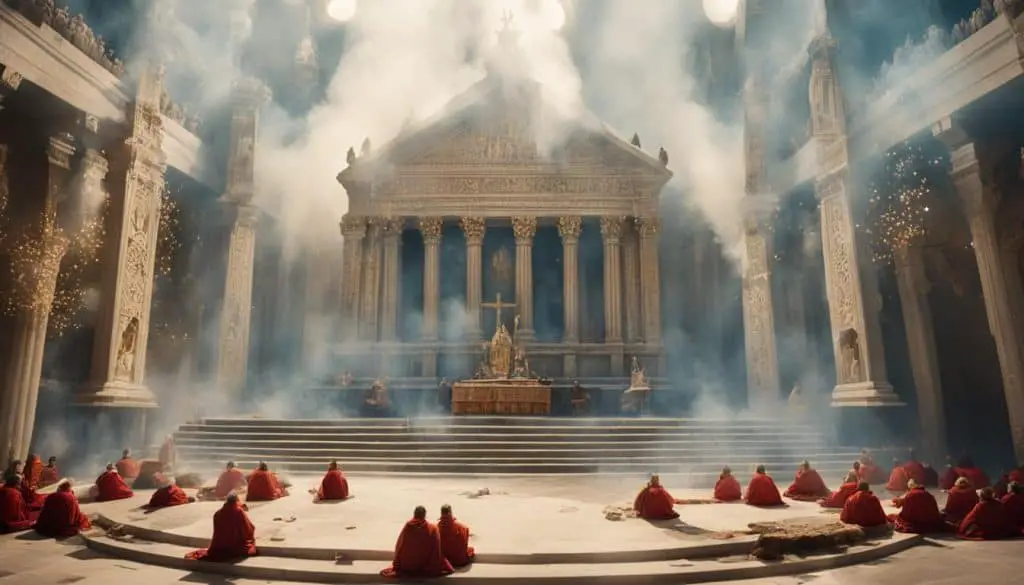
Jesus Teaching in the Temple: Reflecting His Role as Rabbi and Messiah
One of the most impactful aspects of Jesus’ ministry was His teaching in the Temple. As a rabbi, Jesus had the authority to impart knowledge and wisdom to those who gathered to hear Him. He expounded upon the Scriptures, revealing profound truths and insights that captivated His audience.
Jesus’ role as a rabbi went beyond that of a typical teacher. He possessed a divine understanding of the Scriptures and the ability to bring them to life, illuminating their deeper meaning and significance. His teachings were marked by wisdom, clarity, and an unwavering commitment to truth.
By teaching in the Temple, Jesus not only demonstrated His authority as a rabbi, but also revealed His divine mission as the Messiah. His teachings pointed to His role as the fulfillment of Old Testament prophecies and the embodiment of God’s promised salvation.
“I am the way, the truth, and the life. No one comes to the Father except through me.” – Jesus
Through His teachings in the Temple, Jesus challenged traditional religious beliefs and practices, offering a new way of understanding God’s kingdom and the path to eternal life.
He emphasized the importance of faith, love, and compassion, urging His listeners to embrace a personal relationship with God and to live according to His teachings.
The impact of Jesus’ teaching in the Temple cannot be overstated. His words continue to resonate with believers today, guiding them in their spiritual journeys and shaping their understanding of the Gospel. As the ultimate Rabbi and Messiah, Jesus offers wisdom, truth, and the path to eternal salvation.
Jesus’ Key Teachings in the Temple:
- The Sermon on the Mount, where Jesus outlined the principles of the Kingdom of God.
- The Parables, which conveyed profound spiritual truths through simple and relatable stories.
- The Divine Authority of Jesus, where He declared Himself the Messiah and affirmed His identity as the Son of God.
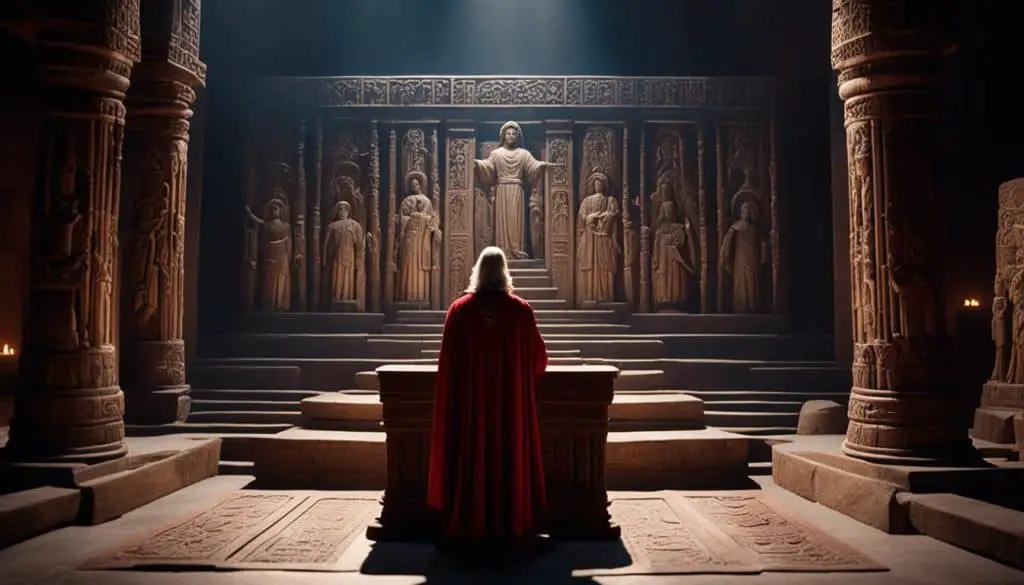
The image above depicts a vivid portrayal of Jesus teaching in the Temple, surrounded by a crowd of eager listeners. It captures the essence of His role as a rabbi and Messiah, conveying the profound impact of His teachings on those who sought to learn from Him.
Solomon’s Temple Dedication: Seeing Christ in Solomon’s Prayer
During the dedication of Solomon’s Temple, King Solomon offered a heartfelt prayer to God. This prayer not only expressed Solomon’s dedication to building a house for the Lord but also contained elements that pointed to Christ and His role in our worship.
In his prayer, Solomon acknowledged that the heavens and the highest heavens could not contain God, highlighting His greatness and transcendence. This recognition foreshadows Christ’s divinity and His ability to bridge the gap between heaven and earth.
Furthermore, Solomon’s prayer included petitions and praises that align with the mission and teachings of Jesus.
Solomon prayed for forgiveness, expressing the need for God’s mercy and grace. This mirrors Christ’s message of forgiveness and redemption, emphasizing the importance of reconciling with God through Him.
“When they sin against You (for there is no one who does not sin), and You become angry with them and deliver them to the enemy, and they carry them away captive to the land of the enemy, far or near; yet when they come to themselves in the land where they were carried captive, and repent, and make supplication to You in the land of those who took them captive, saying, ‘We have sinned and done wrong, we have committed wickedness’; and when they return to You with all their heart and with all their soul in the land of their enemies who led them away captive, and pray to You toward their land which You gave to their fathers, the city which You have chosen and the temple which I have built for Your name: then hear their prayer and their supplication in heaven Your dwelling place, and maintain their cause, and forgive Your people who have sinned against You, and all their transgressions which they have transgressed against You; and grant them compassion before those who took them captive, that they may have compassion on them”
Moreover, Solomon’s prayer encompassed an understanding of the human condition and the need for God’s intervention. This resonates with Christ’s role as the Savior, who came to restore humanity’s relationship with God.
The petitions in Solomon’s prayer emphasize the universal need for salvation and reflect Jesus’ mission to seek and save the lost.
By examining Solomon’s prayer during the dedication of the Temple, we can recognize the foreshadowing of Christ’s work and ministry.
It reveals the profound connection between the Old Testament and the fulfillment found in Jesus Christ. Solomon’s prayer points to the relevance of Christ in our worship and serves as a reminder of God’s faithfulness throughout history.
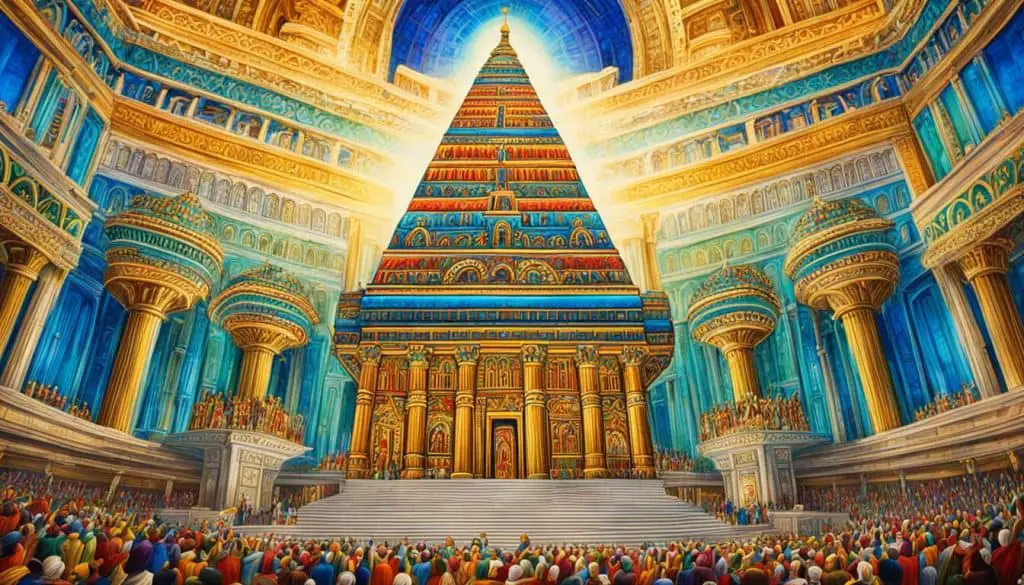
The New Jerusalem: Eternal Worship connected to Jesus
In the book of Revelation, the description of the New Jerusalem reveals a profound connection to Jesus, emphasizing the eternal worship that believers will experience in His presence.
This heavenly city, an awe-inspiring vision, represents the culmination of God’s redemptive plan and the ultimate destination for His people.
Within the New Jerusalem, the presence of Jesus permeates every aspect, instilling an eternal atmosphere of worship.
As believers gather in this celestial dwelling, they will experience the fullness of communion with their Savior, engaging in unending praise and adoration.
The New Jerusalem serves as a testament to the eternal nature of worship. It signifies that our relationship with God and our expression of reverence and worship will transcend time and space.
In this heavenly city, worship is not limited by earthly constraints or fleeting moments, but rather, it is a perpetual, unceasing act.
As we delve deeper into the significance of the New Jerusalem’s connection to Jesus, we gain a glimpse of the eternal bliss that awaits those who have put their faith in Him.
It solidifies our understanding that worship is not merely a temporary endeavor but an everlasting privilege, a never-ending symphony of praise.
The New Jerusalem reminds us that our worship is not confined to earthly sanctuaries or specific rituals.
Instead, it encompasses the fullness of our beings, an eternal response to the salvation and grace found in Jesus Christ. It is a holistic expression of our love and devotion, extending beyond our mortal lives into the eternal realm.
“And I saw no temple therein: for the Lord God Almighty and the Lamb are the temple of it.” – Revelation 21:22 (KJV)
This verse from Revelation encapsulates the essence of the New Jerusalem, highlighting the absence of a physical temple. Instead, the Lord God Almighty and Jesus Christ, the Lamb, serve as the eternal temple.
This vivid imagery emphasizes the personal and intimate connection believers will have with God and Jesus in the New Jerusalem, where worship will be a perpetual state of being.
The New Jerusalem: A Vision of Eternal Worship
In this vision of the New Jerusalem, worship is not bound by time or location. It is an eternal experience characterized by the presence of God and Jesus.
As we strive to understand and participate in worship today, we can draw inspiration and anticipation from the promise of the New Jerusalem, knowing that our worship will one day be perfected in the eternally glorious presence of our Savior.
| Key Elements | Significance |
|---|---|
| The absence of a physical temple | Emphasizes the direct communion between believers and God |
| The eternal presence of God and Jesus | Establishes an atmosphere of continuous worship |
| The absence of sorrow, pain, and death | Creates an environment conducive to unhindered worship |
| The brilliance and splendor of the city | Elevates the magnificence and grandeur of worship in the New Jerusalem |
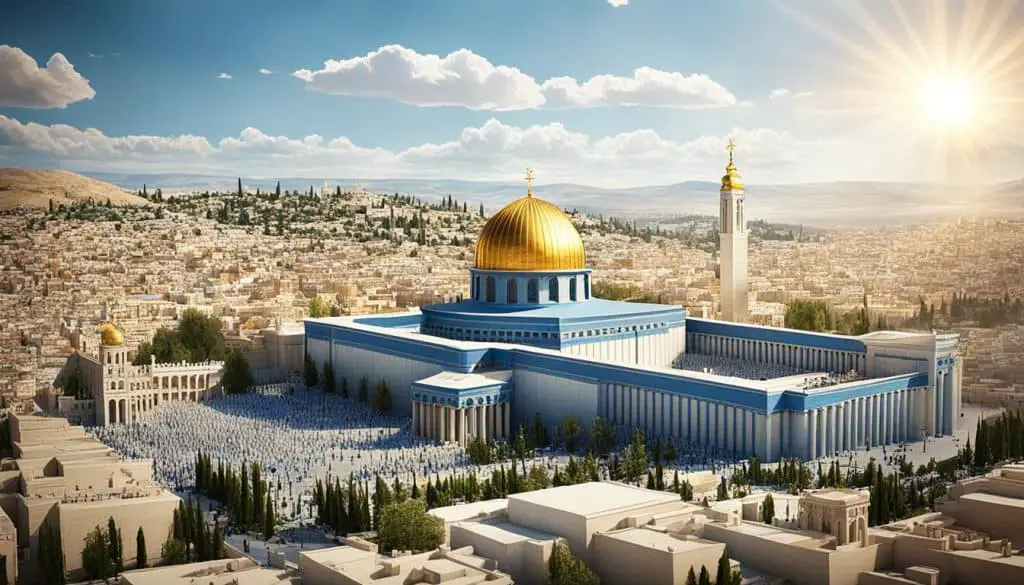
The vision of the New Jerusalem stirs within us a desire for eternal worship. It assures us that our worship today is not in vain but a foretaste of the glorious worship to come.
As we experience the joy, intimacy, and transformative power of worship in our present lives, we can eagerly anticipate its full realization in the New Jerusalem alongside our Savior, Jesus Christ.
The Temple as God’s Dwelling Place: Transition from Temple to Jesus’ Incarnation
The temple was not merely a physical structure but represented God’s dwelling place among His people.
It served as a sacred space where the divine presence resided, allowing for communion between God and His chosen ones. The grandeur and sanctity of the temple emphasized the holiness of God and His desire to be close to His people.
However, with the advent of Jesus’ incarnation, a profound transition took place. God, who had previously dwelled in the temple made by human hands, now chose to dwell among humanity in the person of Jesus Christ.
This transition marked a significant shift in how God’s presence was experienced and worshiped.
Jesus, who is described as the Word made flesh, became the ultimate dwelling place of God.
In Him, the divine presence resided fully, and through His life and ministry, God demonstrated His unending desire to be with His creation. Jesus embodied the temple’s purpose—to facilitate communion and relationship with God.
Through His teachings and miracles, Jesus invited people to experience the presence of God in a personal and transformative way.
He spoke of the kingdom of God being near, bringing the divine realm into the everyday lives of His followers. His ministry became a living temple, a space where God’s grace and love were made manifest.
The transition from the physical temple to Jesus’ incarnation extended an invitation to all people, regardless of their social status or religious background, to approach God directly.
Gone were the barriers and limitations of the temple’s rituals and regulations. Jesus’ sacrificial death on the cross tore the veil that separated humanity from the Holy of Holies, granting access to God’s presence for anyone who believes in Him.
“For in him dwelleth all the fullness of the Godhead bodily.” – Colossians 2:9 (KJV)
Through Jesus’ incarnation, God dwelled among His people in a profound and personal way. The physical temple, once the focal point of worship, was transformed into a symbol of the ultimate sacrifice and the fulfillment of God’s plan for redemption. The dwelling place of God moved from a fixed location to the hearts of believers.
The Impact on Worship and God’s Presence
This transition had a significant impact on the understanding of worship and the presence of God. Worship was no longer confined to a particular location but became a lifestyle of surrender and adoration.
Believers were called to present their bodies as living sacrifices, offering themselves wholly to God. The focus shifted from external rituals to internal transformation.
| Transition | Implications |
|---|---|
| From Temple as a Physical Structure | To Jesus as the Incarnate God |
| God’s presence limited to a specific place | God’s presence accessible to all through faith in Jesus |
| Worship centered around religious rituals | Worship as a lifestyle of surrender and devotion |
| Human efforts to reach God through sacrifices | God reaching out to humanity through Jesus’ sacrifice |
As believers, we now have the privilege of carrying God’s presence within us. Our bodies are temples of the Holy Spirit, and our lives are testimonies of His transforming power.
Worship is no longer limited to a specific time or place but encompasses every area of our existence. We can approach God boldly and intimately through Jesus, experiencing His presence wherever we are.
Understanding the transition from the temple to Jesus’ incarnation deepens our appreciation for the significance of His sacrifice and our role as worshipers. We are called to live as temples of the living God, bringing honor and glory to His name in all that we do.
Zion in Hebrews 12: Connecting Mount Zion to Jesus and the Heavenly Assembly
In the book of Hebrews, the author draws a significant connection between Mount Zion, Jesus, and the heavenly assembly. This connection serves to deepen our understanding of Jesus’ role as the ultimate source of worship and salvation.
The author of Hebrews highlights the importance of Mount Zion as a symbolic representation of God’s presence and His dwelling place among His people. In Hebrews 12:22-23, it states:
But ye are come unto mount Zion, and unto the city of the living God, the heavenly Jerusalem, and to an innumerable company of angels, to the general assembly and church of the firstborn, which are written in heaven, and to God the Judge of all, and to the spirits of just men made perfect.
This passage reveals that believers have come to Mount Zion, not in a physical sense, but in a spiritual and heavenly reality. It signifies our access to the heavenly assembly, which includes a multitude of angels, the church of the firstborn, God the Judge of all, and the spirits of the righteous.
By connecting Mount Zion to Jesus and the heavenly assembly, the author of Hebrews emphasizes the superiority of Jesus’ role in our worship and salvation.
Jesus is the ultimate High Priest who offers Himself as the perfect sacrifice, providing a way for believers to approach God’s presence with confidence and boldness (Hebrews 10:19-22).
In Hebrews 12:24, it states:
And to Jesus the mediator of the new covenant, and to the blood of sprinkling, that speaketh better things than that of Abel.
This verse affirms Jesus’ role as the mediator of the new covenant, which surpasses the offerings and sacrifices of the Old Testament, represented by the blood of Abel. Jesus’ sacrifice speaks of better things, bringing forgiveness, reconciliation, and eternal salvation to those who place their faith in Him.
Through the connection between Mount Zion, Jesus, and the heavenly assembly, we are reminded of the glorious reality of our worship.
It is not limited to earthly temples or physical locations but extends to the heavenly realms, where Jesus intercedes on our behalf and invites us into intimate communion with God.
Comparing Earthly Temples and Heavenly Worship
| Earthly Temples | Heavenly Worship |
|---|---|
| Physical structures | Spiritual and heavenly reality |
| Restricted access | Access for all believers |
| Temporal and temporary | Eternal and everlasting |
| Symbolic representations | Fullness of God’s presence |
| Dependent on human mediation | Mediated by Jesus Himself |
This table highlights the stark contrasts between earthly temples and heavenly worship.
While earthly temples were physical structures with restricted access and dependent on human mediation, heavenly worship transcends these limitations. It is a spiritual and eternal reality, accessible to all believers through Jesus’ mediation.
The connection between Mount Zion, Jesus, and the heavenly assembly serves as a powerful reminder of the centrality of Christ in our worship. It invites us to shift our focus from earthly temples to the heavenly realms, where Jesus reigns as our High Priest and the ultimate source of worship and salvation.
Jesus as the True Temple: Transforming Our Understanding of Worship
Jesus, in His profound wisdom, described His own body as a temple, revolutionizing our understanding of worship and deepening our relationship with God.
This revelation challenges traditional notions of worship tied solely to physical spaces and rituals, inviting us to embrace a more intimate and personal connection with the Divine.
By referring to Himself as the True Temple, Jesus emphasizes that the essence of worship lies not in external structures or practices but in the transformation of our hearts and the surrender of our lives to Him.
Through His life, death, and resurrection, Jesus opened a new way for us to approach God, tearing down the barriers that separated humanity from the fullness of His presence.
“Destroy this temple, and in three days I will raise it up.” – John 2:19 (KJV)
In these words, Jesus foreshadowed His death and resurrection, highlighting that worship is not confined to a particular location but is found in Him, the embodiment of God’s love and grace.
When we grasp the significance of Jesus as the True Temple, it transforms how we engage in worship.
We no longer depend on externalities or performative acts; instead, we focus on cultivating a genuine, inner connection with God through faith in Jesus Christ.
The significance of Jesus’ statement reaches beyond the metaphorical realm. As followers of Christ, we personally become part of His body, sharing in His divinity and participating in the ongoing work of redemption and reconciliation.
“Now, therefore, ye are no more strangers and foreigners, but fellow citizens with the saints, and of the household of God; Andare built upon the foundation of the apostles and prophets, Jesus Christ himself being the chief corner stone.” – Ephesians 2:19-20 (KJV)
Just as the Old Testament temple was a place where God’s presence dwelled, we, as believers, are temples of the Holy Spirit (1 Corinthians 6:19). Therefore, our entire lives, not just designated religious gatherings, become expressions of worship, reflecting the indwelling presence of God.
Transformation of Worship
The transformation of worship through Jesus as the True Temple calls us to a deeper level of authenticity, intimacy, and wholehearted devotion.
It compels us to align our thoughts, words, and actions with the teachings and example of Christ, embracing a holistic lifestyle of worship that encompasses every aspect of our lives.
Jesus’ words resonate with incredible power and meaning, inspiring us to let go of external religiosity and surrender ourselves completely to Him.
In doing so, we discover that worship is not limited to a specific time or place but becomes a continuous outpouring of love, gratitude, and obedience in response to God’s immeasurable goodness.
This transformation of worship invites us to seek God’s presence in every moment, to honor Him with our bodies, minds, and spirits, and to engage in worship that is characterized by authenticity, sincerity, and reverence.
As followers of Christ, we are called to be living temples, reflecting His love and grace to the world. Just as the physical temple in Jerusalem was a place of encounter with God, we have the privilege and responsibility of carrying His presence wherever we go.
In light of Jesus as the True Temple, our worship is no longer confined to physical structures but expands to encompass every moment of our lives.
May we embrace this transformative truth and allow our worship to permeate every area of our existence, leading us into a deeper, more intimate relationship with the living God.
The Final Temple Vision in Ezekiel: Pointing Forward to Perfected Worship in Christ
Ezekiel, a prophet in the Old Testament, had a profound vision of the final temple, which serves as a powerful foreshadowing of perfected worship in Christ.
In this vision, Ezekiel witnesses a temple that is filled with God’s glory and represents a restored and renewed covenantal relationship between God and His people.
The details of Ezekiel’s vision reveal how this final temple differs from its predecessors. It emphasizes a deep spiritual connection with God, rooted in sincere devotion and a renewed understanding of His holiness.
“And the Lord said unto me, Son of man, describe the temple to the house of Israel, that they may be ashamed of their iniquities: and let them measure the pattern. And if they be ashamed of all that they have done, shew them the form of the house, and the fashion thereof, and the goings out thereof, and the comings in thereof, and all the forms thereof, and all the ordinances thereof, and all the forms thereof, and all the laws thereof: and write it in their sight, that they may keep the whole form thereof, and all the ordinances thereof, and do them.”
Ezekiel’s vision reflects the physical and symbolic aspects of worship within the final temple. It conveys the importance of both external and internal purity, highlighting the need for genuine repentance and a transformation of the heart.
This vision not only points forward to the future of worship in Christ but also serves as a reminder for believers today. It emphasizes the significance of wholehearted devotion, authenticity in worship, and a deep reverence for God’s presence.
The Significance for Believers Today
The final temple vision in Ezekiel carries several key implications for believers today:
- Perfected worship in Christ: The final temple vision points forward to a time when worship will be fully perfected in Christ. It reminds us that our worship is not limited to physical spaces but extends to our whole lives, as we surrender ourselves completely to Him.
- Renewed covenantal relationship: The vision highlights the restoration of God’s covenantal relationship with His people. As believers, we are called to enter into a deep and intimate relationship with God, motivated by genuine repentance and a desire to know Him more.
- The importance of purity: Ezekiel’s vision emphasizes the significance of both external and internal purity in worship. It prompts us to examine our lives, purging ourselves of anything that hinders our relationship with God and cultivating a heart that is pure and devoted to Him.
As we reflect on Ezekiel’s vision of the final temple, let us embrace the call to perfected worship in Christ. May we continually seek a deep and genuine connection with God, offering Him our wholehearted devotion and surrendering to His transformative power in our lives.
Psalms of Ascent: Preparing Hearts for Temple Worship and Jesus
The Psalms of Ascent, consisting of Psalms 120-134, served as a powerful tool for preparing the hearts of pilgrims for temple worship. These psalms were sung by the Israelites as they ascended to Jerusalem to participate in the various feasts and celebrations at the temple.
Through their lyrical expressions of praise, gratitude, longing, and repentance, these psalms guided the worshipers in their spiritual journey towards encountering God in the sacred space of the temple.
The Psalms of Ascent prepared the hearts of the pilgrims by:
- Inspiring reverence and awe: The psalms invited the worshipers to reflect on the greatness and holiness of God, setting the tone for approaching the temple with deep respect and humility.
- Expressing adoration and thanksgiving: These psalms overflowed with expressions of praise and gratitude, encouraging the worshipers to enter the temple with hearts full of joy and thankfulness for God’s goodness and faithfulness.
- Invoking a spirit of unity and fellowship: As the pilgrims sang these psalms together, they experienced a sense of community and shared purpose, strengthening their bonds as they journeyed towards the temple.
- Facilitating personal reflection and repentance: The psalms also provided opportunities for introspection, prompting the worshipers to examine their hearts, seek forgiveness, and commit themselves to a righteous life before entering the temple.
While the primary purpose of the Psalms of Ascent was to prepare the hearts of the worshipers for temple worship, these psalms also foreshadowed the coming of Jesus and prepared the hearts of believers for His arrival.
Through their poetic imagery, prophetic themes, and longing for God’s presence, these psalms created a spiritual atmosphere that directed the hearts and minds of the worshipers towards the ultimate fulfillment of worship in Jesus Christ.
Just as the pilgrims eagerly ascended to the temple, we too can journey through the Psalms of Ascent, allowing them to prepare our hearts to encounter Jesus in our worship and deepen our understanding of His redemptive work.
“I was glad when they said unto me, Let us go into the house of the Lord.” – Psalm 122:1
Themes in the Psalms of Ascent
| Theme | Key Psalms |
|---|---|
| Longing for God’s Presence | Psalms 121, 122, 123 |
| Praise and Thanksgiving | Psalms 124, 126, 129 |
| Unity and Fellowship | Psalms 133, 134 |
| Repentance and Forgiveness | Psalms 130, 131, 132 |
What is the significance of Zion in biblical worship and prayer?
Zion’s prayers for Jerusalem hold significant meaning in biblical worship and prayer. Zion is often referenced as a symbol of God’s presence and the ultimate destination for believers. The prayers for Jerusalem, the holy city, reflect the longing for peace and prosperity, illustrating the importance of Jerusalem in biblical teachings.
The Tabernacle’s Blueprint: Foreshadowing Christ and God’s Plan for Salvation
The intricate design of the tabernacle in the Old Testament holds a deeper significance than meets the eye. Its blueprint serves as a foreshadowing of the coming of Christ and reveals God’s plan for salvation.
As you examine the meticulous details of the tabernacle’s construction, you can uncover profound insights into how it points to Jesus and His redemptive work.
Every aspect of the tabernacle, from the structure to the furnishings, carries symbolic meaning that foreshadows the ministry of Christ. The sacrificial system in the tabernacle, with its rituals and offerings, hints at Jesus’ ultimate sacrifice for the forgiveness of sins.
The Holy of Holies, veiled from view, represents the separation between God and humanity, a division that Jesus bridged through His death and resurrection.
Furthermore, the tabernacle’s design highlights God’s intricate plan of salvation. The meticulous instructions given for its construction demonstrate God’s attention to detail and desire for a close relationship with His people.
The tabernacle’s emphasis on holiness and purity reflects the need for atonement and anticipates Jesus, the sinless Lamb of God who would cleanse us from all unrighteousness.
By studying the tabernacle’s blueprint, we not only gain insight into the craftsmanship of the Israelites but also witness the intricate tapestry of God’s plan for our redemption.
It reminds us of the profound love and intentionality with which God pursued our salvation through His Son, Jesus Christ. The tabernacle serves as a powerful testament to the divine wisdom and foresight woven into every detail of Scripture.

